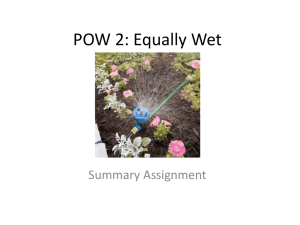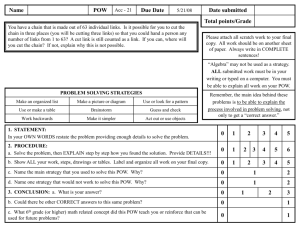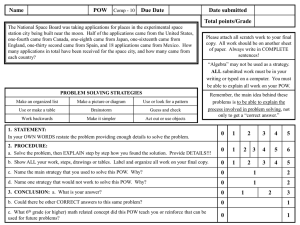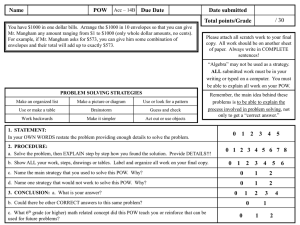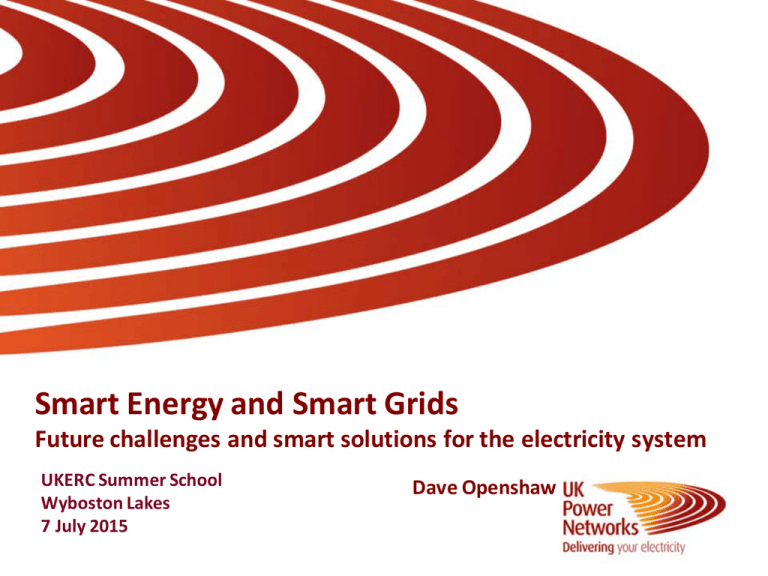
Smart Energy and Smart Grids
Future challenges and smart solutions for the electricity system
UKERC Summer School
Wyboston Lakes
7 July 2015
Dave Openshaw
UK Power Networks
Consumers
Million
8.1
Service Area
km²
29,250
Underground
Network km
139,024
Overhead
Network km
46,704
Energy Distributed
TWh
84.8
Peak Demand
GW
16.2
UK Power Networks holds three electricity distribution licences: EPN (serving the East
of England) SPN (serving the South-East of England) and LPN serving the bulk of London
2011. UK Pow er Netw orks. All rights reserved
2
GB electricity system topology
132,000 volts
33,000 volts
Wind farms
25,000 volts
400,000 and 275,000 volts
Railway
supplies
Solar PV farms
Distribution substation
11,000 volts
Primary
substation
400/230 volts
11,000 volts
National Grid
entry point
exit point
Distributed Generation I&C consumers
SME consumers Domestic consumers Homes with Street furniture
micro-generation
•
Electricity transmission is at 400kV or 275kV in England and Wales (also 132kV in Scotland) - typical electricity
distribution voltages are 132kV, 66kV, 33kV, 11kV, 25kV (rail traction) and 400/230V
•
Major power stations, large offshore windfarms and European interconnectors are connected to the transmission
system but renewable generation (mainly onshore wind and solar PV) and CHP is now increasingly being
connected to distribution systems
© 2011.
2011. UK
UK Pow
Power
Networks.
Al lrights
rightsreserved
reserved
er Netw
orks. All
3
Future challenges and smart solutions
Context
• The UK Carbon Plan
• Future energy scenarios
Implications for supply and demand
• Future generation scenarios
• DG and micro-generation scenarios
• Demand growth scenarios
• EV charging and heat pump demand scenarios
Wider system implications
• Frequency stability
• Power quality
• Voltage management
Smart solutions
• Smart metering
• Smart grid solutions
Overall implications for the electricity distribution business model
• The evolution from passive to smart DNO
• The transition from smart DNO to Distribution System Operator
2011. UK Pow er Netw orks. All rights reserved
4
Decarbonisation – the role for renewable
generation, heat and transport
•
The Carbon Plan sets out how the UK will achieve decarbonisation within the framework of
energy policy: to make the transition to a low carbon economy while maintaining energy
security, and minimising costs to consumers
•
The UK renewable Energy Roadmap identifies a range of renewable generation technologies
which will make a significant contribution to UK’s ‘15% by 2020’ renewable energy target
•
Renewable heat, heat pumps and electric vehicles will displace conventional fossil fuel based
technologies and further contribute to UK’s decarbonisation targets
•
The UK Solar PV Strategy has the ambition of approaching 20GW of solar PV capacity early in
the next decade (from 2020)
2011. UK Pow er Netw orks. All rights reserved
5
Future energy scenarios (National Grid)
• National Grid has developed four
energy scenarios which consider
different futures for electricity
• Gone Green, Slow Progression and
Low Carbon Life all emphasise low
carbon generation but whilst GG and
SP assume large scale renewables, LCL
assumes a greater contribution from
micro-generation and DG
• GG and LCL both assume significant
growth in EVs but only GG assumes
significant growth in heat pumps.
Source – National Grid Future Energy Scenarios
2011. UK Pow er Netw orks. All rights reserved
• No Progression reflects economic
constraints on achieving
decarbonisation ambitions
6
Implications for supply and demand
2011. UK Pow er Netw orks. All rights reserved
7
Future generation
scenarios
solar
nuclear
gas
CCS
offshore wind
onshore wind
2011. UK Pow er Netw orks. All rights reserved
interconnectors
Source – National Grid Future Energy Scenarios
8
‘Low Carbon Life’ DG and micro-generation
projections
Distributed generation
with installed capacity
above 1MW
DG and micro-generation
with installed capacity
below 1MW
• This scenario implies a major shift from centrally dispatched ‘synchronous’
generation to widely distributed - but intermittent - forms of generation
2011. UK Pow er Netw orks. All rights reserved
Source – National Grid Future Energy Scenarios
Scenario: Low Carbon Life
9
Penetration of renewable generation
(example EPN network)
•
Significant areas of UK
Power Networks’ EPN
region are now
approaching DG
saturation levels
•
Across UKPN, accepted
connection offers for DG
developments >5MW
have been received for:
• Kings Lynn
• Norwich
• Peterborough
- 2731MW of solar PV
- 343MW of onshore
wind
• Cambridge
• Ipswich
- 605MW other
• Luton
• Aylesbury
• Chelmsford
• Tilbury
© 2011. UK Power Networks. Al l rights reserved
10
Electricity demand scenarios
• These charts show the wide
variations in peak power
demand and annual
consumption under different
scenarios
• Low Carbon Life and Gone
Green are characterised by
significant demand increases
but with different
trajectories – albeit
converging beyond 2025
• Under No and Slow
progression, demand
continues to fall with little or
no recovery
Source – National Grid Future Energy Scenarios
2011. UK Pow er Netw orks. All rights reserved
11
EV and heat pump demand
Source – National Grid Future Energy Scenarios
2011. UK Pow er Netw orks. All rights reserved
• Gone Green and Low Carbon Life project
high exponential growth in EV demand
• Gone Green projects a similar growth rate
in heat pump demand
• Under Slow and No Progression EV
demand growth accelerates slowly
12
Wider system implications
2011. UK Pow er Netw orks. All rights reserved
13
Frequency stability challenges
•
Wind and solar PV generation has minimal short-run marginal cost of
production and hence will always have higher ‘merit order’ than other
generation technologies (even nuclear)
•
Hence under future low demand / high (wind and solar PV) generation
scenarios, synchronous generation will be constrained off
•
In these circumstances, system inertia will be low resulting in reduced
frequency stability (higher rate of change of frequency)
•
In the event of a major loss of infeed this will lead to an enhanced risk of
frequency collapse leading to wide scale supply interruptions – including
operation of low frequency demand disconnection relays
Source – National Grid System Operability Framework
14
Power quality challenges
•
A further consequence of
reduced synchronous generation
is lower system strength
•
Under future low demand / high
(wind and solar PV) generation
scenarios system fault levels will
decline well below current levels
•
This will lead to power quality challenges in the form of deeper and more
prolonged voltage dips and increased harmonic distortion
•
A further effect will be a possible system resonance shift to lower order harmonics
Source – National Grid System Operability Framework
2011. UK Pow er Netw orks. All rights reserved
15
Voltage management challenges
•
Reactive / real powwer ratios are declining – i.e. reactive exports at GSPs are falling faster than power exports
•
A number of possible reasons – e.g. increased cable capacitance, less reactive demand, energy efficient
lighting (CfLs exporting VArs) and distribution connected solar PV
•
At many GSPs distribution networks are exporting VARs to the transmission system – in 2013 DNOs were net
suppliers of reactive power to the transmission system for 39% of the time
•
REACT project (NG led with DNO support) is exploring reasons but no firm conclusions as yet
•
ENTSO-E Demand Connection Code may disallow VAr exports from Distribution to Transmission systems
•
If this trend continues, DNOs will need to develop more comprehensive voltage management techniques
•
The T&D interface is not unique – DNOs may begin to experience issues at each voltage transformation stage
•
HV/LV substations will be particularly challenged due to continued proliferation of rooftop solar PV
Source – National Grid System Operability Framework
2011. UK Pow er Netw orks. All rights reserved
16
Smart solutions
2011. UK Pow er Netw orks. All rights reserved
17
Smart metering system
Smart
Electricity
Meter
Comms Hub
In-Home Display
Data via two communication service
providers (CSP) and one data service
provider (DSP) – each contracted to DCC
CSPs - Arqiva (North)
Telefonica (Midlands
& South)
Single licensed Data
Communications Company (DCC)
Capita
DSP - GGI
WAN technology: long range radio and GPRS
Home area
network (HAN)
technology:
2.4GHz and
868MHz ZigBee
Micro-generation
(FIT) meter
Consumer Access
Devices / Smart
Appliances
Power status polling
Load switch operation
Messaging
Power outage alerts
Voltage level (hh avg. rms)
Hi/Lo voltage alert
Extreme Hi/Lo voltage alert
Voltage sag/swell log
MD (hh avg.)
Network Operator
4Q hh profile
Asset Management
& Control Centre
Network Operator
Revenue
Management
D Flows
DUoS charges
DCC
Central Hub
HH consumption
Messaging
Tariff change
etc.
Suppliers
•
From DCC Live (2016) and up to completion of rollout (2020?) DNOs will have an increasingly comprehensive
(and necessary) suite of LV network utilisation data – along with real-time power outage and power quality data
•
But processes and systems will be necessary to extract the benefits whilst meeting the licence obligation
regarding protection of data privacy
© 2011. UK Power Networks. Al l rights reserved
18
Smart grid solutions (example UKPN projects)
UK Power Networks is developing and trailing a range of ‘smart grid’ solutions to
the emerging low carbon challenges to our business. Some of these projects
combine technological and commercial innovation to provide solutions not only
to resolve local network challenges but also the wider GB system challenges
1. Low Carbon London - industrial & commercial demand side response
2. Low Carbon London – residential dynamic time-of-use tariff
3. Flexible Plug & Play Networks – smart grid and communications technologies and
active network management to provide headroom for renewable DG
4. Smarter Network (electricity) Storage – distribution network and wider system support
5. KASM (Kent Active System Management) – management of a highly active network
through a contingency analysis tool – minimising constraints on DG export
6. Fault Current Limiter – creating additional headroom for urban DG
Further information on UK Power Networks’ smart grid projects can be found on our innovation website:
http://innovation.ukpowernetworks.co.uk/innovation/en/
2011. UK Pow er Netw orks. All rights reserved
19
Case Study 1 - Low Carbon London - I&C Demand Response
The challenge
• highly loaded substations
• requirement to design to
remain firm under n-1
• typically brief periods when
substation is out of firm
• extremely expensive and
disruptive grid reinforcement
4 x 15MVA
33/11kV
intact
The opportunity
I&C customers with flexible demand and/or standby generation
• air cooling load, industrial scale refrigeration, supermarket lighting
N-1
• Ideally dispatching post-fault and only when demand exceeds firm capacity (to minimise
constraints on availability of DSR for other purposes – e.g. flexible STOR / DSBR)
• obviating the need for costly and disruptive network reinforcement
• maximising capability of DSR to provide whole-system benefits
The LCL trial
• 18MW of DSR - 77% generation, 23% demand turn-down - procured across 37 sites
• Dependability assessed at 70 – 80% for generation, 54 – 64% for demand turn down
• Sufficient confidence to defer £43m reinforcement for UKPN’s networks over ED1
2011. UK Pow er Netw orks. All rights reserved
20
I&C Demand Response
required demand response for various demand characteristics
Demand above firm capacity
Firm capacity
Potential DSR dispatch event
Demand
Note: DSR dispatch
would normally occur
only under unplanned
network single circuit
outage conditions –
hence potential
conflict with other calls
on DSR (e.g. STOR) is
small (esp. summer
peaking substations)
Source: Poyry – Low Carbon London Project – synergies and conflicts in the use of DSR for national and local issues
2011. UK Pow er Netw orks. All rights reserved
21
Case Study 2 Low Carbon London residential dynamic
time-of-use tariff tariff
Trial purpose: to investigate the network demand impact of dynamic ToU Tariffs
designed to maximise usage of zero carbon / marginal cost generation
‘Economy Alert’ tariff details:
• Designed by EDF Energy
• 1100 trial participants (plus control group)
• 12 month trial
• Smart meters installed by EDF Energy
• Emulating ‘wind following’ tariff
• based on historic wind data
• reflecting day-on-day and within day
variation in generation output
• Strong price (per kWh) signals
• 67.20p HIGH
• 11.76p NORMAL
• 3.99p LOW
• Min 24 hour notice
• Message delivered via IHD with SMS option
2011. UK Pow er Netw orks. All rights reserved
22
Dynamic Time of Use Tariffs
Results
Default price
Low price
Mean DSR (kW)
High price
Household performance rank
against
measured DSR, by price band
Rank
of households
2011. UK Pow er Netw orks. All rights reserved
23
Dynamic Time of Use Tariffs
Consumer behaviour insights
•
•
•
•
As anticipated, ‘wet’ appliances appear to have the greatest flexibility
Tariff complexity appears not to be an issue for most consumers
Many appeared to welcome the organisational planning imposed by the day-ahead
pricing notification
In general, customers appear to be keen to participate in Time of Use tariffs
Appliances for which households reported flexibility in
avoiding high prices on the tariff
2011. UK Pow er Netw orks. All rights reserved
24
Case study 3 - Flexible Plug & Play Networks
facilitating renewable generation
The Challenge:
• Generator dominated
network
• Additional wind and solar
PV farms wishing to
connect
• Existing network constraints
• Potentially prohibitive
connection charges
• Unacceptable delays in
connection
• Undermining business case
for projects
2011. UK Pow er Netw orks. All rights reserved
25
Flexible Plug & Play Networks
The Solution:
• Dynamic line ratings
• Active DG management
• Quad booster
• IEC 61850 communications
• Innovative contracts – quotabased DG curtailment
quad booster
Current status:
• 54.40MW of accepted offers (15 projects) within the
trial area of which 24.75MW is now connected
• Expected annual curtailment given anticipated
diversity of output with current mix of generation ~2%
radio mesh comms
2011. UK Pow er Netw orks. All rights reserved
26
Case study 4 - Smarter Network Storage
grid-scale electrical energy storage (Leighton Buzzard)
• 6MW / 10MWh Li Ion Battery
• Installed adjacent to Leighton Buzzard
33/11kV substation
• Restoring firm capacity to the substation
and avoiding need for a 3rd 33kV circuit
and 33/11kV transformer
• Batteries charged during off-peak
periods – available for dispatch in the
event of an outage during a peak period
Li Ion batteries
Battery and power electronics enclosure
• Market opportunities include:
- Power Purchase Tolling Agreements with
Suppliers
- TRIAD avoidance
- STOR and Fast Reserve service to the SO
- Dynamic and Fast Frequency Response
services to the SO
2011. UK Pow er Netw orks. All rights reserved
27
Smarter Network Storage
leveraging the capability across the supply chain
2011. UK Pow er Netw orks. All rights reserved
28
Smarter Network Storage
Functionality
Peak Shaving
SNS uses its stored energy to meet peak demand which reduces the load
on the network. This defers the need for network reinforcement to meet
peak demand.
Frequency Regulation
SNS can regulate the grid frequency through power exchanges. This assists
National Grid in stabilising the frequency of the wider electricity system.
Reactive Power Support
SNS has 7.5MVAr of reactive power capability. Reactive power can improve
power factor, reduce losses and support voltage levels on both the local
network and wider system
Reserve
Tolling / Wholesale Market
SNS provides reserve capacity and can be triggered remotely to export
power. This assists National Grid in balancing electricity demand and
supply.
SNS can provide energy based on a given energy delivery profile. This can
be used to manage imbalance risk and assist in hedging against peak
electricity prices; including reducing TRIAD charges for Suppliers
2011. UK Pow er Netw orks. All rights reserved
29
Case study 5 – Kent Active System Management (KASM)
2011. UK Pow er Netw orks. All rights reserved
•
Network runs interconnected with NG
transmission system
•
650MW of connected generation
(mainly wind)
•
300MW additional generation seeking
connection (mainly solar PV)
•
Two existing interconnectors (France
2GW and Netherlands 1GW)
•
Two additional interconnectors planned
(1GW France and 1GW Belgium)
30
KASM - Contingency Analysis Tool
• Multiple scenarios for
variable generation
export and
interconnector flows
• Parts of distribution
network approaching
reverse power limits
• 34 contingency
scenarios need to be
analysed
• Worse case scenarios
surrounding minimum
demand / maximum
generation (no
diversity) and
unplanned outage
• Need to be able to
quickly determine
generation constraint
actions
• Essential to have realtime monitoring and
contingency analysis
capability
2011. UK Pow er Netw orks. All rights reserved
31
Case study 6 - Short Circuit Level Management
Features and benefits:
• Fault Current Limiter (pre-saturated core)
• HV fault current / voltage dip limiting
• Maintaining low source impedance
• Allowing greater penetration of DG
2011. UK Pow er Netw orks. All rights reserved
32
Implications for the electricity distribution
business model
2011. UK Pow er Netw orks. All rights reserved
33
The current evolution from ‘passive’ to ‘smart’ DNO
Traditional Distribution Network Operator
Managing a Largely Passive Network
Passive - Smart Transition
Smart Distribution Network Operator
Managing an Increasingly Smart Network
Smart Grid Technologies to Support an Active Network
Advanced Control Room Operating
& Network Visualisation Systems
Active Network Management
Self- Reconfiguring Networks
On-line Diagnostics
PMUs Monitoring & State
Estimation
Advanced SCADA &
Telecommunications
Actively Dispatched DSR & DG
Phase Shifting Transformers
Network Connected Storage
Fault Current Limiters
Integrated Voltage & PF Control
D-Stacoms & Switched Capacitors
Voltage Regulators & Phase
Balancers
Dynamic Line & Plant Ratings
Adaptive Protection
Network Meshing & Soft NOPs
34
2011. UK Pow er Netw orks. All rights reserved
The future evolution to Distribution System Operator
Future Distribution System Operator
Smart Distribution Network Operator
Managing an Active Network and Supporting System Balancing
Managing an Increasingly Smart Network
Flexible Demand
Smart Grid Technologies to Support an Active Network
Demand Response
DG Constraining
on/off Contracts
Distributed Storage
Energy Storage
Smart Appliances
Air Cooling
Heat Pumps
Electric Vehicles
DNO – DSO Transition
Di s patchable Resources
Balancing & Reserve Services
Transmission
SystemServices
Operator
Balancing & Reserve
Suppliers & Intermediaries
Ancillary Services
System Balancing Frequency Control & Constraint Management
Bid – Offer Acceptances
Supplemental
Balancing Reserve
Demand Side Balancing
Reserve
Fast Reserve
STOR / Flexible STOR
Frequency Response
Black Start
Pre-Gate Closure Contacts
Pre-Gate BM Unit Transactions
Ancillary and Commercial Services
Reactive power
Commercial Aggregation
Virtual Power Plants
Demand Side Management
Energy Efficiency
Smart metering
Commercial Building Energy
Services
Home Energy Services
Flexible Tariffs
2011. UK Pow er Netw orks. All rights reserved
Balancing & Reserve Services
Customer Services
35
Thank you

